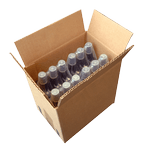Case Packing
Some companies keep track of case-packed items separately from open stock. For some types of businesses a company might even have multiple case packings for the same product, and may keep track track of the stock quantities separately of each type of packed case. This video demonstrates how to use Finale Inventory’s case packing feature to efficiently organize and track items in cases.

Case packing video tutorial
Video Transcription
Hi, this is Will of Finale Inventory. I’m going to give a quick demonstration here of how you user the case packing feature to keep track of your inventory in terms of individual items or each’s, or in terms of cases, or a combination of both. So, we’ll start on the beginning screen with the products. All of the commands that we can do are the blue links and the products coming in from the left from our suppliers through purchases. The center column being the links relevant to transactions that take place on our facility and then leaving through sales to customers on the right.
So, when we talk about casing or case packing, we’re talking about cases of items that where a number of the items are combined into a case. Usually a product has a standard packing of this certain number of items that fit in a case. In special cases, you may have different packings for different cases, and that’s okay too. But for the simple case, let’s walk through just an example on where we’re going to keep track of items individually and items in cases of a specific case item count inside the case.
So, I’m going to go to view products in the center here. And select pies, here we are. I just typed in the search column blueberry to filter down to the blueberry pie item. Clicking on that to get its detail and then I wanted to call your attention here to this field for this product called The Standard Packing Field. And I can type anything I want in here. I’m going to type in 6 and 1 to indicate that these blueberry pies are packed six per case. And save this product. Okay. Having done that now, we can see how that is relevant to creating a sale of products and we can see how that’s relevant to keeping track of our products. If I go to view stock at the top, I’ll be able to see how many blueberry desserts I have. So again, to pare down the list from all of the products in this account to just the blueberry pie is I’m gonna type blueberry up there.
And I see that for the blueberry pies, I have an open stock over here on the right in these two columns, I have 386 individual items and none of them are reserved, so all 386 of them are available. Similarly, in case stock, I am keeping 148 cases of those items already packed into cases, and they are all available. They are kept in three locations, one, two, and three. If I click the link on the left, I get the details telling me what numbers add up to that 386 and what numbers add up to that 148. Specifically, for the case stock, I have 98 cases packed to 61 and I have 50 cases pack to 12.
Okay. So, that’s how I keep track of my stock in terms of cases or individual units. If I make a sale, I can specify that the sale includes units or cases either way. So, let’s sell one case, two cases of blueberry pies for quantity. Instead of just typing in two which would be two individual items, I’m going to type two CS for cases. And it fills in the details 12 and 1, if you remember that’s what we typed on that earlier screen. Save now. We’ve created this order. Now, we can ship the order by clicking on the shipments tab, updating the shipment to match the order.
Noticing that for this order we have an order for two cases and the shipments going to include two cases. Shipped from location number three with this particular lot, if I want details or if I want to change the cases that I’m shipping, I could do that by expanding the turny-downy triangle on the left and changing that number shipped. But that was the number that I wanted which is what we set up by default, so I just save this here and ship the shipment.
(Videos: See complete list of available videos)




